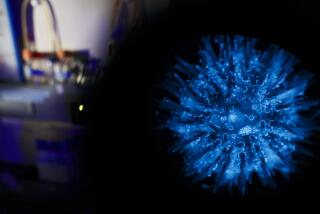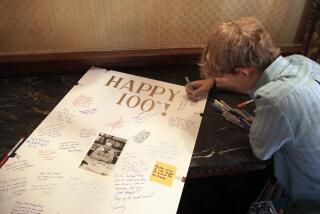Manu Prakash, newly minted MacArthur ‘genius,’ builds water computers and origami microscopes
The solutions to global health problems usually come with a hefty price tag. Manu Prakash is working to change that.
Among his many inventions is the Foldscope, a lightweight microscope made from a single sheet of paper that costs less than $1 to build. He has also created a tiny chip that can analyze the contents of mosquito saliva that could help people stay ahead of infectious disease outbreaks.
Ideas like these helped earn Prakash one of the MacArthur Foundation’s prestigious “genius grants.” The Stanford University physical biologist and inventor will receive $625,000 over five years, which he can spend any way he likes.
“It’s not written anywhere how scientists should do science,” he said. “Every scientist is unique.”
Prakash is fascinated by the natural world — both living and nonliving systems, and the ways that their behaviors often resemble one another. He has examined how shorebirds nab prey and how insects land on water. He studies self-assembly, the tendency of materials or living things to form organized structures without the need for a central architect.
“I consider myself really, really, really lucky to be able to do science as a profession, and to think about science in general,” he said. “I worry about the vast majority of people who don’t get that chance.”
His interest in what he calls “frugal science” goes back to his childhood. Growing up in Rampur, India, he played in an abandoned chemistry lab, ogling containers of sulfuric acid, liquid mercury and crystalline powders.
He was about 9 when he tried to build his first microscope. He used cardboard tubes that previously held badminton shuttlecocks and lenses from his brother’s glasses. (It didn’t work.)
In the years since, Prakash has dreamed up and built all kinds of devices.
He’s made a “water computer” that uses droplets as its bits of information. While this device will probably never operate as fast as a traditional computer, he and his team have been beefing it up. In 2007 they built a single fluidic logic gate, and they’re currently working with hundreds in the lab now.
Such a computer could lead to new manufacturing techniques. Current methods require doing one thing after another. But a computer that manipulated matter could build composite materials and structures more in the way that a plant does, able to sprout branches in different places at the same time.
“The long-term goal is truly to build completely new kinds of things,” Prakash said. “Do we know as yet the kinds of things we will be able to make using these methods? The answer to my mind is, ‘Not yet.’”

There’s also Foldscope, which can be assembled like origami from a paper with embedded electronics and lenses.
“The first one was made out of a matchstick box,” Prakash said. Several years later, “we’re still iterating, we’re still modifying, we’re still changing, we’re still adding functionality. ... It’s quite a versatile medium to build out of.”
The inexpensive and portable system is meant to help researchers when they’re roughing it in the field, as well as bring budding scientists from economically disadvantaged communities into the fold.
Prakash has set up a website for Foldscope users from around the world to share their findings made with the device. One recent contributor was a 6-year-old girl from North Carolina who was studying crystals.
Prakash is also working on another cheap device: a tiny microfluidic chip that can collect tiny droplets of saliva from mosquito bites. With the help of a punchcard and a handcrank, those saliva samples could be screened for pathogens. This information, if crowdsourced around the world, could help public health researchers predict outbreaks of mosquito-born diseases.
“By sharing our tools, we can engage with a much broader group of scientists,” he explained, “especially scientists from countries that have infectious disease challenges that are uncontrolled.”
This sort of citizen science is common in other fields, said Lakshminarayan Iyer, a computational biologist at the National Institutes of Health and a Foldscope “superuser.” Astronomers, for instance, can upload their huge datasets of images and ask for help going through it all.
But citizen science for what Iyer called the “microcosmos” — the world of things smaller than a millimeter, invisible to the naked eye — has until now been pretty sparse. Plenty of people have access to a computer; fewer have easy access to a microscope.
“Manu has a kind of vision which is very unique, in that it’s not just about making something cheap,” Iyer said. “It’s also about building a community ... and giving the opportunities for people to go out and share their observations or build something around them.”
Prakash, so interested in the science of self-assembly, is helping a scientific community to self-assemble.
Follow @aminawrite on Twitter for more science news and “like” Los Angeles Times Science & Health on Facebook.
MORE IN SCIENCE
MacArthur winner Victoria Orphan showed how deep-sea microbes keep greenhouse gas out of atmosphere
MacArthur Fellow Jin-Quan Yu breaks some of nature’s strongest bonds to synthesize new molecules







